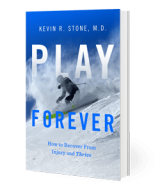Sports Injury Depression
You ski fast. You make one small error. You get back on the tails of your skis, but one ski skids out to the side. That’s when you hear a pop, and you get a nauseating feeling in your stomach.

This article is an excerpt from Dr. Stone's book Play Forever.
Your binding hasn’t released; it’s your knee that has given way. Your ACL—the key stabilizer of the knee—has ruptured as your shin bone is locked in your ski boot. Your ACL moved forward while your thigh bone, or femur, moved backwards.
After your fall, you try to get up. But when you put pressure on the ski, your knee buckles. Intuitively you know what you have done, though you hope it isn’t so.
The ski patrol arrives, checks you out, loads you into the toboggan, and slides you down to the mountain base clinic. There, you encounter four other people with the same story. A brief exam by the all-knowing medical staff, a recommendation to see your orthopaedic surgeon when you get home, and an ice bag for your knee are your souvenirs, marking the early end of your vacation.
There is a morbid frenetic excitement about the whole process. You realize that your ski season is over and your plans for the spring are up in the air. You make multiple phone calls to see the top doctor, the one you have heard has the best results. Finally, the exam confirms the diagnosis. The X-rays show your healthy bones and the MRI shows the ruptured ligament. You schedule the surgery, meet with the physical therapists, and reorganize your life and work.
Finally, the surgery happens. All goes well. You begin your rehab, but a couple of weeks later, you hit the skids. You’ve had it. You are sick of the soreness, the dressings, the ice machines, the knee braces, and the physical therapist appointments. You just want your life back.
There’s a name for this malaise. You have officially acquired “ACL depression syndrome.” A recent study documented that 40 percent of people who undergo ACL surgery experience clinically diagnosable depression. Life disruptions are a drag, especially when they put the brakes on your active lifestyle.
Of course, sports injury depression is not just confined to those with ACL ruptures. Any major injury can cause our mental wheels to spin out. Perseveration—a recycling through the mind of thoughts that won’t go away—traps you in the pain or anger of a past event. It can be hard to break free.
Sports injury depression may not seem to be in the same league as PTSD, suicidal ideation, or other severe depressive disorders. But it is far more common. We have all encountered an unexpected injury that derails us. The sudden calamity first produces anger, then sorrow, and the long recovery from surgery induces another type of anguish. But chronic injuries can leave you with pain of the worst type as it seems your life will never be as good again.
In the pharmaceutical world, anti-depressants are often prescribed for this spiral, with wildly varying results. In the sports world, these drugs decrease performance. However, since most injured athletes were not depressed before they were hurt, they don’t see themselves as needing or wanting a “psychiatric” drug treatment. In the experimental world combining both science and recreation, the use of hallucinogens is teaching us interesting lessons. When Timothy Leary lectured in the late 1960s that a single LSD trip led to permanent improvement in some people’s outlook on life, he was right. Current studies are trying to understand the phenomenon of therapeutic, professionally guided “trips.” Results suggest that these therapies have the potential of curing PTSD, addiction, and severe depression.
The guided psychedelic therapies appear to work like this: once a person sees himself or herself floating in space, free of the rigid attachment to the trauma that holds them down, they recognize the person they could be, rather than the angry, depressed person they are. This experience of joy may clear the cobwebs or actually rewire the brain. It can be convincing enough to change the course of a person’s life.
After sports trauma or surgery, we seek the same release. We coach our patients to see themselves as athletes in training, not as patients in rehab. If the injured can view their injury as an excuse to train more creatively and work around their injury while that part of the body heals and if they can use the gift of downtime to rethink their approach and reduce the likelihood of future injuries, then they have the possibility of returning from their injury in better shape than they were before they were hurt. This requires letting go of anger about the injury, or about any previously failed surgeries, or about the person who may have caused the injury. It requires letting go of perseveration and envisioning a new, positive goal.
The tools we use to help athletes get to this point include coaching with hands-on physical therapy, where the touch and experience of a skillful therapist dramatically builds confidence while mobilizing stiff tissues. Daily sweat workouts are creatively designed to protect the injured part of the body while raising the heart rate. Pilates, pool exercise, upper-body weight lifting—we recommend them all. Muscle building releases pheromones, testosterone, adrenaline, and dopamine, which enter the bloodstream and reset the competitive athletic spirit. Combining a vision of who you can become with this level of coaching is a tremendously effective healing strategy.
Sports injury depression is endemic to all athletes who begin as driven, healthy, fit, and life-loving people. In a moment, they become victims of a sports injury, facing an uncertain future. Those who buy into the importance of an ambitious exercise and fitness program succeed in warding off the depression, or at least in shortening its length and intensity. The cure for sports injury depression is to set your goal to become fitter, faster, and stronger than you were before you were injured and to achieve it.

